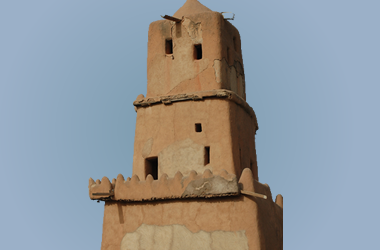The Gobarau (or Gobirau) minaret (in Hausa, Hasumiyya) is a 50-foot edifice located in the centre of the city of Katsina, the capital of Katsina State. The Gobarau minaret, a symbol of the state, is an early example of Islamic architecture in a city that prides itself as an important Islamic learning centre. The minaret is believed to be West Africa’s first multi-storey building and was once the tallest building in Katsina.
History
The Gobarau minaret is part of a mosque which was built in Katsina in the fifteenth century during the reign of Sarkin (King) Katsina Muhammadu Korau (1445–1495 AD) - the first Muslim king of Katsina. Other sources suggest that it was built between the sixteenth and eighteenth centuries, with a major reconstruction taking place in the early twentieth century.
The mosque's origin is attributed to the efforts of the influential Islamic scholar Sheikh Muhammad Abdulkarim Almaghili and Muhammadu Korau. Almaghili was from the town of Tlemcen in present-day Algeria and taught for a while in Katsina when he visited the town in the late fifteenth century during the reign of Muhammadu Korau. He and Korau discussed the idea of building a mosque to serve as a centre for spiritual and intellectual activities. The Gobarau mosque was designed and built to reflect the Timbuktu-style of architecture. It became an important centre for learning, attracting scholars and students from far and wide, and later served as a kind of university.
Another popular myth about its origin states that when Muhammadu Korau slew Jibda-Yaki Sanau, the last pagan king of Katsina, he wished to construct a mosque to celebrate his victory. When the site was selected, there arose a problem about the Qiblah – where the mosque must face. Korau consulted Muslim scholars of the time and all agreed, except one, Mallam Jodoma, that the new mosque must face a certain direction. After much argument, with the majority of the scholars trying to persuade the king to accept their decision, an angry Jodoma pointed his staff in the direction of his choosing and there appeared the Ka'abah – the Muslim holy stone. This convinced the king and he made Jodoma his first chief imam. However, he was eventually banished after the other scholars convinced the king that Jodoma sought his throne. Jodoma settled at Guga, a village in the present-day Bakori LGA of Katsina State, where he died.
The minaret, said to have originally been some 120 meters tall, is all that remains of the mosque constructed in Habe times (pre- Islamic times) before the Fulani jihad of Usman Dan Fodio. It was originally built to serve as the central mosque of Katsina town but was later used as a school. By the beginning of the sixteenth century, Katsina had become a very important commercial and academic centre in Hausaland, and the Gobarau mosque had grown into a famed institution of higher Islamic education. Gobarau continued to be Katsina's central mosque until the beginning of the twentieth century, when Sarkin Ummarun Dallaji (1906–1944) built a new mosque, which was later demolished by Muhammadu Dikko, who built the famous Masallacin Dutsi, which is still used up to this day. The mosque and tower were renovated most recently by Sarkin Muhammadu Kabir Usman (1981–2008).
Location
The Gobarau minaret is located within the Gobarau quarters along old Market Road in the Katsina LGA. The Gobarau Primary School lies to its south, and to its north are residential buildings. It is about five minutes' walk away from the seat of the Katsina Emirate.
Structure
The minaret was made by local craftsmen from a combination of clay, straw, animal blood, mud, palm timbers, karite (a vegetable butter), and conical bricks (known locally as tubali). Date palms (azara) were used for the roofing, doors and windows. It has three floors which decrease in size as the building rises and which are connected by a interior staircase. There are several holes in its walls, which were used during times of war to sight approaching enemies.
Significance of the Gobarau Minaret
The Gobarau minaret is a testimony to the historical interactions among the people of western and central Sudan, the Magreb and Middle East, from the visit of Sheikh Muhammad Abdulkarim Almaghili to Usman dan Fodio’s jihad. Its similarity to the building designs of the Mali and Songhai empires underscores the political relationships between these ancient kingdoms as well as the transmission of local indigenous knowledge and skills. It is an example of traditional Hausa architecture and the use of sustainable local resources to create a long-lasting monument.
As a religious centre, it was a place of learning for subjects such as Qur’anic recitation and memorisation, jurisprudence, history and philosophy. It also recalls Habe period that preceded the Fulani jihad and its image is widely used as part of the official insignia of Katsina State.
Recent History and Preservation
No written evidence has been found for what led to the abandonment of the Gobarau mosque. However, some reasons advanced for its decline include the proliferation of mosques in every quarter of the city; the establishment of Quranic schools in the entrance halls to local houses and the construction of a new central mosque by Ummarun Dallaje, the first Fulani Emir of Katsina, shortly after he came to power in 1807.
In 1927, Mr. E. Mart, one of the teachers at the famous Katsina College, took a photograph of the remains of the minaret. The picture generated concern among the people of Katsina and the British Colonial Officers. As a result, Emir Alhaji Muhammadu Dikko of Katsina commissioned a group of master builders to restore the minaret. The rehabilitation was carried out successfully and the minaret as seen today is the product of that exercise.
The Gobarau mosque and minaret were initially under the custody of the Katsina Emirate Council before being taken over by the federal government in 1959 when it declared the minaret a national monument of Nigeria. However, the Emirate Council still plays a vital role in the maintenance of the 664-year old edifice.
In 2004, the Emirate Council carried out some further rehabilitation work on the minaret and in 2009, the American Embassy also did similar renovation work.
The Role of the Sarkin Magina of Katsina
For the past fifty years, the Sarkin Magina of Katsina (the leader of traditional architects), has been the overseer of Gobarau minaret who leads local builders in the renovation works on the minaret.
Alhaji Ma’aruf Audu Gafai, the current Sarkin Magina, alleged that the colonial rulers had once attempted to move the minaret to Jos in Plateau State having sought permission from Emir Usman Nagoggo, and he and other thirteen prominent local builders were taken to Jos for the construction of a similar minaret and other traditional structures similar the Katsina emir’s palace. However, they refused to construct a replica of Gobarau minaret despite spending three years on the project in order to prevent the destruction of the original Gobarau.
Tourism
The Gobarau minaret is a major tourist attraction in Katsina State, along with the Kusugu well in Daura. Researchers from within and outside Nigeria troop to there to see the historic legacy left behind by its architects. According to the visitors’ book at Gobarau minaret, researchers, students and even lecturers from Germany, England, America, Argentina, Sudan, Morocco, Canada, Ghana, and Cameroon among other countries, visit the site regularly.
Sources
Sunday Trust
Shelf3d
Wikipedia
Peoples Daily
Africa Today
Picture source: Wikimedia Commons


